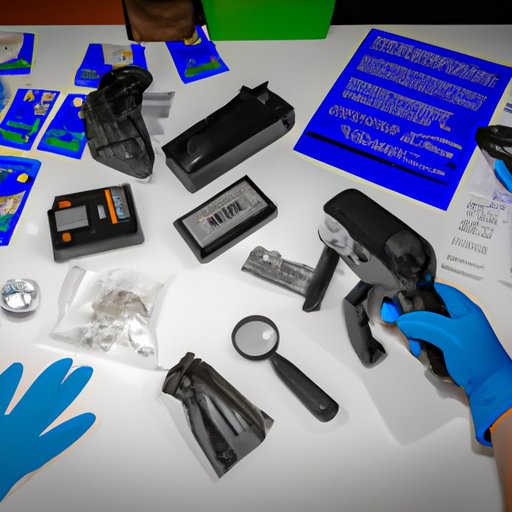Introduction
Forensic photography is a specialized form of photography used by law enforcement and other legal professionals to document evidence and clues related to a crime. This type of photography requires a great deal of skill and knowledge in order to accurately capture and preserve evidence for further investigation. In this article, we will explore what forensic photography is, how it is used in law enforcement, the importance of forensic photography, and the techniques used in forensic photography.

A Comprehensive Guide to Forensic Photography
Let’s start by taking a closer look at what forensic photography is and how it is used in law enforcement.
What Is Forensic Photography?
Forensic photography is a type of photography used to document evidence related to criminal cases. It involves taking detailed photographs of the crime scene and any evidence or clues that may be present. This type of photography is an essential part of any crime scene investigation, as it helps to preserve details that may otherwise be missed or overlooked. The photographs can then be used as part of the evidence in court proceedings.
How It Is Used in Law Enforcement
Forensic photography is used by law enforcement personnel to document the details of a crime scene. The photographs taken are used to create a visual record of the scene, which can help investigators piece together what happened. The photographs can also be used to identify suspects or victims, as well as to provide evidence for court proceedings. In some cases, the photographs can even be used to identify objects or weapons that were used in the commission of a crime.
The Importance of Forensic Photography
Forensic photography is an important tool in any criminal investigation. By documenting the details of a crime scene, it helps to preserve evidence that may otherwise be lost or destroyed. In addition, the photographs can be used to prove the guilt or innocence of a suspect in court proceedings. Finally, the photographs can provide valuable insight into the events leading up to and following a crime.
Exploring the Techniques Used in Forensic Photography
Now that we’ve explored what forensic photography is and how it is used in law enforcement, let’s take a look at the techniques used in this type of photography.
Tools and Equipment Used
Forensic photographers use a variety of tools and equipment to document a crime scene. They typically use cameras with high resolution and wide angle lenses to capture as much detail as possible. In addition, they often use tripods and flashlights to ensure their photographs are clear and accurate. Other pieces of equipment, such as filters and photo editing software, can also be used to enhance the quality of the photographs.
Different Types of Shots
Forensic photographers must be aware of the different types of shots they need to take in order to properly document a crime scene. These include close-up shots, mid-range shots, panoramic shots, and aerial shots. Each of these shots serves a specific purpose and should be taken in order to capture all of the relevant details.
Post-Processing Images
Once the photographs have been taken, they must be post-processed in order to make them suitable for use in court. This can involve using photo editing software to enhance the quality of the images, as well as to adjust the lighting, color balance, and contrast. Post-processing images also allows forensic photographers to remove any unwanted elements from the photograph, such as fingerprints or debris.

The Role of Forensic Photography in Crime Scene Investigations
Now that we’ve explored the techniques used in forensic photography, let’s take a look at the role it plays in crime scene investigations.
Documenting Evidence
Forensic photography is used to document evidence at a crime scene. This includes photographing physical evidence, such as fingerprints, footprints, and blood spatter. It also includes photographing items of clothing or other personal belongings that may be present. Photographs of the crime scene can also be used to create a timeline of events, as well as to help investigators determine the order in which things occurred.
Preserving Clues
Forensic photography is also used to preserve clues that may not be readily visible to the naked eye. For example, a photograph of a footprint can be used to determine the size and shape of the shoe that was worn by the perpetrator. Similarly, a photograph of a handprint can be used to determine the size and shape of the hand that touched the object. By preserving these clues, forensic photography can help investigators to build a stronger case.
Conclusion
In conclusion, forensic photography is a specialized form of photography used by law enforcement and other legal professionals to document evidence and clues related to a crime. It involves taking detailed photographs of the crime scene and any evidence or clues that may be present. The photographs can then be used as part of the evidence in court proceedings. Forensic photography is an important tool in any criminal investigation, as it helps to preserve evidence that may otherwise be lost or destroyed. Additionally, the photographs can provide valuable insight into the events leading up to and following a crime.
The benefits of using forensic photography include the ability to document evidence and preserve clues that may not be visible to the naked eye. However, there are also some limitations to using this type of photography. For example, the photographs can be difficult to interpret without proper training and experience. Additionally, the photographs can be affected by environmental factors, such as lighting and weather conditions. Despite these limitations, forensic photography remains an invaluable tool for crime scene investigations.
(Note: Is this article not meeting your expectations? Do you have knowledge or insights to share? Unlock new opportunities and expand your reach by joining our authors team. Click Registration to join us and share your expertise with our readers.)
